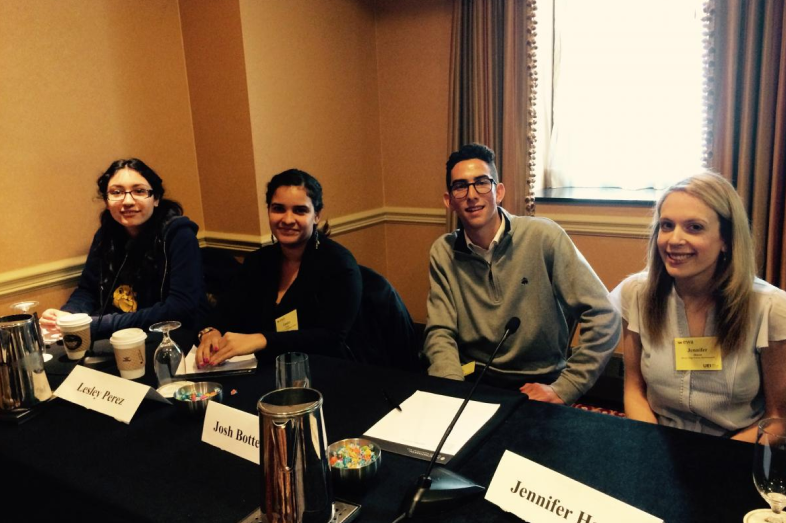

If teachers and principals want students on center stage in their classrooms, they’ll first have to do a lot of work backstage. However, as a panel of teachers and students told attendees at EWA’s recent National Seminar in Chicago, the return on investment can be substantial.
When Revere High School, outside Boston, began moving to a more student-centered approach, the educators didn’t expect an overnight miracle.
“Administration told us you don’t have to be this amazing flipped-learning teacher tomorrow,” said Jennifer Hayes, who teaches English to English-language learners. Step by step, Revere’s teachers mastered new technology to support student-centered learning. Eventually they were creating instructional videos for students to watch at home, freeing up class time for collaborative projects and sharing student work via iPads.
But it takes more than technology to create a student-centered classroom. Teachers need to do more than just move to the side—they must listen to students’ ideas and work them into lessons and projects.
“They’re teaching me as much as I’m teaching them,” said Hayes. “That’s one of the biggest transitions.”
Even with new mindsets and tools, keeping students consistently at the center of the action can be hard.
“Setting up the environment [for students to take charge of their learning] is still one of the hardest things” about managing a student-centered classroom, said Lesley Perez, an eighth-year teacher at Chicago Public Schools’ Chavez Multicultural Academic Center. The open-enrollment public campus is part of an initiative being funded by LEAP Innovations, an educational technology nonprofit hub focusing on school redesign in the Windy City. There are many days when her students tackle projects in groups, ask each other questions, and pursue their own ideas. But “it doesn’t work like that for me every single time,” Perez told the EWA audience. “It’s an ever-learning process.”
Even High Tech High, the San Diego-area charter school network founded on the principle of student-centered learning, has faced challenges. Students and teachers who felt more comfortable in traditional classrooms left, recalled Josh Botterman, a recent graduate of High Tech High’s Chula Vista campus who was part of the panel discussion. Those who stayed sometimes struggled to switch gears between student-driven projects and standardized tests. When test time arrived, Botterman said he heard a very different message than usual from teachers: “OK, let’s buckle down for a week and get ready for this thing.”
But when smart school leaders want to innovate, they can make it happen, regardless of school type or setting. While High Tech High is a charter, both Chavez and Revere are neighborhood public schools. All three have large populations of students from low-income families, ranging from 42 percent at High Tech High to 99 percent at Chavez. And all three have shown strong academic results on state and local accountability systems. While High Tech High has been a leading high-performer from the beginning, Chavez and Revere both used the student-centered approach to boost their accountability ratings from mediocre to outstanding.
Although the tools to support student-centered learning get a lot of attention, what schools do with their time matters at least as much. Revere shelved a traditional high school schedule—six 45-minute periods—in favor of four 80-minute daily blocks, plus a small-group advisory session three times a week. Teachers of common subjects meet twice a week to plan the project-based lessons on which student-centered learning thrives.
Giving students more flexibility with time matters, too. At Chavez, eighth-grader Stephanie Hernandez, squeezes into a car with a half-dozen other students twice a week for a 10-mile trip to one of Chicago’s top-ranked public high schools for geometry class, she said during the panel discussion. The rest of the week, she does geometry homework in Perez’s math class and uses a web-based tool, Aleks, to study at her own pace.
Hernandez acknowledged the challenges when students in the same room are working on different material. “Since we are separate from the class taking the algebra, they look at us like we are different, but [Perez, her teacher,] helps to work that out,” she said. Yet Hernandez also said she appreciates the chance to review algebra topics by helping other students learn them for the first time. The mix of different class settings plus self-paced learning seems to be working for her. Next fall she will attend another of Chicago’s elite high schools, Whitney Young.
With built-in time for internships and projects, High Tech High provided Botterman with the flexibility to explore his interests while connecting them to his academic work. During high school, Botterman and his father started their own baseball-related business.
“I was meeting with executives from the San Diego Padres at noon on a Tuesday,” he said. At a traditional high school, that might have caused problems. But at High Tech High, “I was able to present projects and make this a part of my curriculum.”
High Tech High offered Botterman other valuable experiences in student-centered learning, too, like interviewing prospective teachers and seeing some get hired. At first, that made the transition to college tougher, he observed. “I went from interviewing my teachers to maybe not even knowing my professor because I was in a class of 600 kids.”
But in the long run, “I wasn’t afraid to do college my way,” he said. Bottman, now a third-year student at the University of California, Berkeley, created his own major related to visual design. With the independence and project-management skills fostered by student-centered learning, he said, “you can pave your own path and adapt to whatever environment you are in.”
For more on student-centered learning, see this story by panel moderator David Desroches of WNPR Connecticut Public Radio.